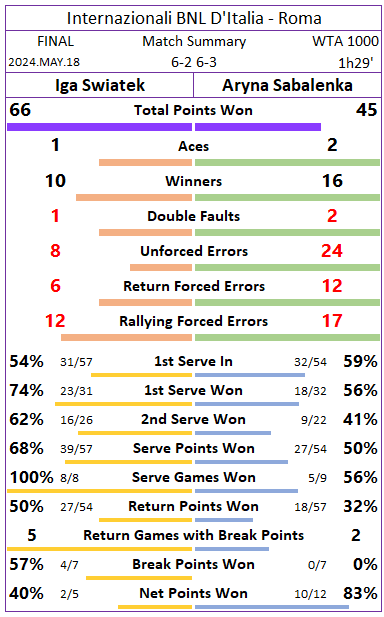Swiatek vs Sabalenka: Roma Final Analysis (WTA 1000)
Half of the errors for the WTA 1000 clay double and a third Italian Open title.
cover 📸 credit: WTA Tour twitter
Two weeks after their epic match in Madrid (read here), Iga Swiatek and Aryna Sabalenka met again to decide the WTA 1000 Roma final.
Swiatek claimed victory once more and that’s where most similarities end. This time, instead of saving 3 match points, Swiatek conceded no more than 3 games in a set. That’s how far apart their performances were.
With made-for-clay groundstrokes, reliable returns and explosive movement, Swiatek was suffocatingly consistent. And despite a low 1st serve percentage during a large portion of the match, her revamped serve motion also shined in several clutch moments.
Opponents feel the pressure whenever Swiatek is in such form, as Sabalenka ackowledged.
“You always know that you have to build the point, and you have to finish the point”.
Sabalenka was great when point construction enabled her to gain position at the net, going 10-for-12 (83%). But everything was different when she didn’t. From the baseline, she went 24-for-67 (36%). On top of that, she accumulated 17 return errors. Afterwards, Sabalenka admited she played impatiently.
With errors piling up at 1:2 rate, Swiatek finished with 27 errors while Sabalenka ended with 55 errors. So they became the ultimate deciders.
All about errors in Roma
Errors: Swiatek 27 / Sabalenka 55
Winners-to-Unforced Errors: Swiatek +2 / Sabalenka -8
Unforced Errors: Swiatek 8 / Sabalenka 24
Rallying Forced Errors: Swiatek 12 / Sabalenka 17
Return Forced Errors: Swiatek 6 / Sabalenka 12
Total Return Errors: Swiatek 7 / Sabalenka 17
Double Faults: Swiatek 1 / Sabalenka 2

The final in Roma can be broken down into three distinct parts.
Set 1
Set 2 start (first 4 games)
Last 5 games of set 2
1 - Set 1
The opening set was lopsided, with Swiatek outscoring Sabalenka 30-16.
Swiatek’s 2 winners may be misleading as her aggression was carried out mostly through pressing, high-percentage groundstrokes and quality serves. They induced 5 forced errors on returns and another 10 during rallies, to make up half of the points won by Swiatek in the set.
For Sabalenka, the start of the match was reminiscent of her Madrid semi-final against Rybakina. With totals of 4 winners to 11 unforced errors, her level was simply not good enough.
Sabalenka was missing too often and too early.
Set 1 points won by rally length
0-4 shots: 23-10 Swiatek
5-8 shots: 5-4 Sabalenka
9+ shots: 3-1 Swiatek
A closer look reveals that most of Swiatek’s 13-point edge in short points came from 1-shot and 2-shot rallies (marked in red, below).
Given that Swiatek began missing 10 of 13 1st serves and her percentage of 1st serves made at the end of the set was still a low 39%, those 8 1-shot rallies (corresponding to unreturned serves) were quite unexpected.
Sabalenka faced only 9 1st serves while seeing 14 2nd serves (13 actually, as there was 1 double fault). But she still missed 8 returns, won just 26% of return points and failed to generate a single break point.
The most puzzling observation was how Sabalenka seemed unsure on her returning strategy. Or at least how she wasn’t confident in adopting an aggressive approach.




